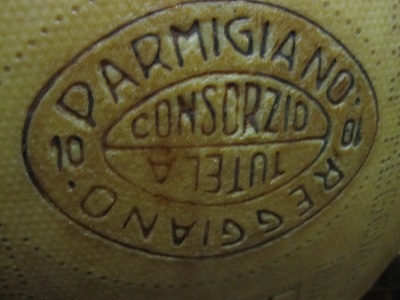I witnessed a birth today. It brought a tear of joy to my (very – literally)weary eyes. Well, really, several births – three sets of twins – and two more sets were born after I left. It was really quite something, especially as these little ones are all destined to be kings. At 10:04am the first set was born. Each weighing in at a healthy 45kg. OK. All of the babes born today, and in fact every day, weigh exactly 45kg.
Each and every morning of the year, five sets of twins are born at San Pier Damiani (caseificio #3333). Most of the dairies certified to produce Parmigiano-Reggiano are of a similar size – it’s an artisan process with each location producing only between 8-12 wheels every day.
If all goes according to plan at this small family run dairy outside of Parma, each one of the 10 will grow up to one day be a wheel of Parmigiano-Reggiano – the king of all cheeses. It’s been this way for nine centuries, since monks collecting milk on horseback, using calves stomachs as a bag of sorts, noticed that by the time they got home, the milk had coagulated – and in fact made a damn fine cheese.
There’s no day off for the 380 approved producers of Reggiano – each afternoon, after milking, Holstein milk from members of the co-operative in Reggio Emilia is delivered to the dairy, where it is laid to rest in open metal pans. The cream rises to the top (as it is want to do), and is skimmed off for Reggiano butter or ricotta (heaven) and other assorted treats.
The following morning, the day’s early morning milk is delivered and mixed with the previous evening’s skimmed milk. Then 1,100 litres are off to the copper kettle, to be cooked to 130F for 10-12 minutes. Calf rennet is added and coagulation begins a few moments later. Curds and whey separate, and fermented whey from the previous day’s batch is added to the mix, while some from today will be pulled off and kept to ferment for the following day – ensuring a little piece of history in every delicious wheel.

The third generation cheese maker patiently breaks the curds, while keeping a careful eye on his son, to be sure that his breaking technique is up to par. Mama is in the background, generally keeping an eye on things and trying not to be too friendly to the “turisti” – Papa is not so keen on that – after all – he’s got work to do.
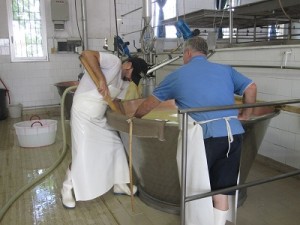
Soon it’s time for the birth. Somehow, some way, father and son wrangle 90kg of curds into cheesecloth, and then divide into two equal parts, known as twins, using another series of cheesecloths. It’s quite amazing to see. My guide tells me that it’s not uncommon at this point in the tour for some guests to ask when the cheese is put into the green cylindrical tins. Seriously.
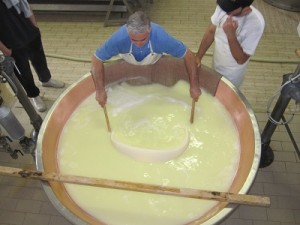
The whey from the kettle is collected to feed the pigs destined to become Parma Ham, and the newborn twins are tied to drain over the kettle – each looking like an extra-large bundle from the stork.
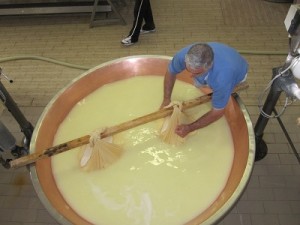
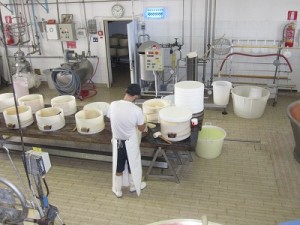
Next, the future kings are formed, with the official imprint of Parmigiano Reggiano, and it’s date of birth. These days it even gets a high-tech QR code, but I am not technologically advanced enough to scan it. (Hey – it’s a miracle I’ve figured out how to post these blogs…..)
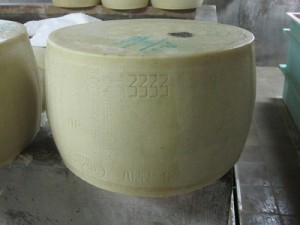
First stop is a few days of rest before 25 day sea salt brine bath. Then it’s time for the aging room for a minimum of 12 months. Each week the wheels are turned, and washed…waiting for their judgement day. It all comes down to the Battitori…..otherwise known as the cheese whisperers, who tap the cheese with a special hammer, and listen to the resulting sound. I’d love to shadow a battitori one day – following him around listening to cheese – listening, I guess for sounds of royalty. If one of these babies makes it, the Battitori may stamp it with his “signature” and place a second stamp indicating quality ranking (first=round, second=square, and triangle=3). Several days later, the “brander” arrives, and depending on how the cheese whisperer has graded the cheese, brands the wheel with the official seal – I like to think of it as graduation day. If a wheel has not made it – it is branded with bands around the wheel – and sent off to be ‘grated cheese’….poor thing. The new kings still have to wait six months before they can be enjoyed, and some will hang out in the aging room for up to 36 months for the honour of being labelled as gold quality.
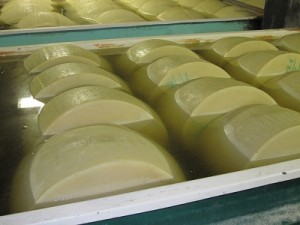

I love Parmigiano-Reggiano – always have. Seeing the incredible hard work it takes to bring it to the table made me appreciate it even more. The fact that it is made according to time-honoured traditions passed on from generation to generation makes me smile. Whenever I have Reggiano at home I’ll think of the family at San Pier Damiani working hard to ensure each wheel is as good as the next, bringing 10 new wheels to life each and every day. How lucky we are they persevere at their craft.
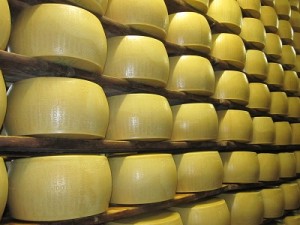
We taste a little 12 and 24 month Parmigiano-Reggiano, with some honey – fantastic. I stock up on some 36 month old gold, a little Reggiano butter – and we are off to our next stop in the land of Parma and delicious things…..
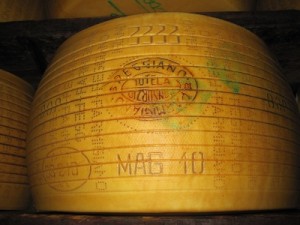
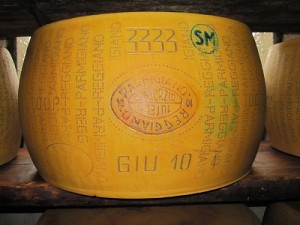
Here’s the consortium’s website – they have tons of great information, including tips on planning visits to a dairy and a spot where you can enter the dairy’s number and find out exactly who made your Parmigiano-Reggiano. http://www.parmigianoreggiano.com/default.aspx
